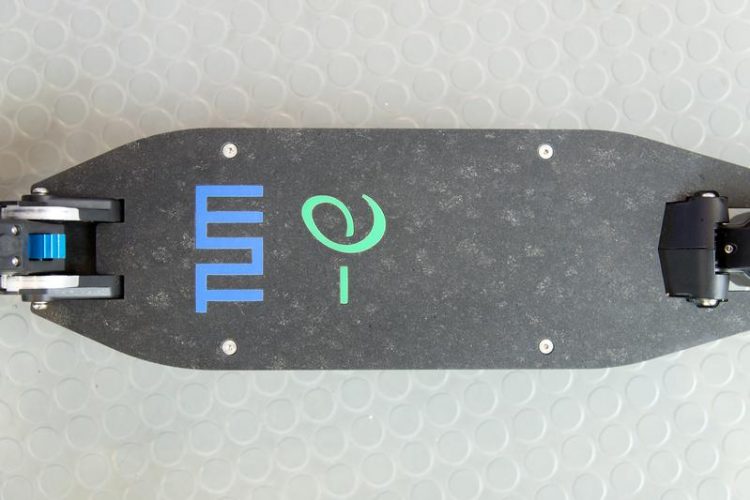Lighter than aluminum and stronger than steel: innovative materials with carbon fibres made from algae

e-scooter step made of a composite material integrating granite and carbon fibers made from algae. Image: Andreas Battenberg / TUM
The most recent global climate report (IPCC Special Report on Global Warming of 1.5 °C) considers manufacturing processes which use more carbon dioxide (CO2) than they release to be an important option to get climate change under control.
The objective of the project started today under the title “Green Carbon” is to develop manufacturing processes for polymers and carbon-based light-weight construction materials based on algae which may be utilised in the aviation and automotive industry, for example.
The development of the various processes is accompanied by technological, economical and sustainability analyses. The German Federal Ministry of Education and Research (Bundesministerium für Bildung und Forschung, BMBF) has dedicated funds amounting to around 6.5 million Euro to fund the research at TU Munich.
Microalgae bind carbon dioxide
Due to their fast growth, microalgae like those cultivated in the globally unrivalled technical algae centre at TUM’s Ludwig Bölkow Campus south of Munich can actively store the greenhouse gas CO2 in form of biomass. CO2 is mainly bound in sugars and algae oil. These can be used in chemical and biotechnological processes to produce precursors for a variety of industrial processes.
For example, oil-forming yeasts produce yeast oil from the algae sugars, which is a feedstock for sustainable plastics. Furthermore, enzymes can split the yeast oil into glycerine and free fatty acids. The free fatty acids are precursors for products like high-quality additives for lubricants, among others; the glycerine can be turned into carbon fibres.
Sustainable production of carbon fibres
In the further course of the project, the plastics will be combined with the carbon fibres to produce corresponding composite materials. “The carbon fibres produced from algae are absolutely identical to the fibres currently in use in the industry,” says project lead Thomas Brück, professor for synthetic biotechnology at TU Munich. “Therefore, they can be used for all standard processes in aviation and automotive production.”
Furthermore, carbon fibres and hard rock can be used in a process of the industrial partner TechnoCarbon Technologies to produce novel construction materials. Not only do they have a negative CO2 balance, they are also lighter than aluminium and stronger than steel.
Prof. Dr. Thomas Brück
Technical University of Munich
Werner Siemens-Chair for Synthetic Biotechnology
Lichtenbergstr. 4, 85748 Garching, Germany
Tel.: +49 89 289 13253 – e-mail: brueck@tum.de
Web: http://www.wssb.ch.tum.de
Carbon Capture and Sustainable Utilization by Algal Polyacrylonitrile Fiber Production: Process Design, Techno-Economic Analysis, and Climate Related Aspects. Uwe Arnold, Thomas Brück, Andreas De Palmenaer und Kolja Kuse, Industrial & Engineering Chemistry Research 2018 57 (23), 7922-7933, DOI: 10.1021/acs.iecr.7b04828
Energy-Efficient Carbon Fiber Production with Concentrated Solar Power: Process Design and Techno-economic Analysis. Uwe Arnold, Andreas De Palmenaer, Thomas Brück und Kolja Kuse. Industrial & Engineering Chemistry Research 2018 57 (23), 7934-7945, DOI: 10.1021/acs.iecr.7b04841
https://www.tum.de/nc/en/about-tum/news/press-releases/details/35079/ Earlier press release on algae carbon fibers
https://www.tum.de/nc/en/about-tum/news/press-releases/details/32656/ TUM-algae cultivation center
https://mediatum.ub.tum.de/1507350 High resolution images
Media Contact
All latest news from the category: Materials Sciences
Materials management deals with the research, development, manufacturing and processing of raw and industrial materials. Key aspects here are biological and medical issues, which play an increasingly important role in this field.
innovations-report offers in-depth articles related to the development and application of materials and the structure and properties of new materials.
Newest articles

NASA: Mystery of life’s handedness deepens
The mystery of why life uses molecules with specific orientations has deepened with a NASA-funded discovery that RNA — a key molecule thought to have potentially held the instructions for…

What are the effects of historic lithium mining on water quality?
Study reveals low levels of common contaminants but high levels of other elements in waters associated with an abandoned lithium mine. Lithium ore and mining waste from a historic lithium…

Quantum-inspired design boosts efficiency of heat-to-electricity conversion
Rice engineers take unconventional route to improving thermophotovoltaic systems. Researchers at Rice University have found a new way to improve a key element of thermophotovoltaic (TPV) systems, which convert heat…



